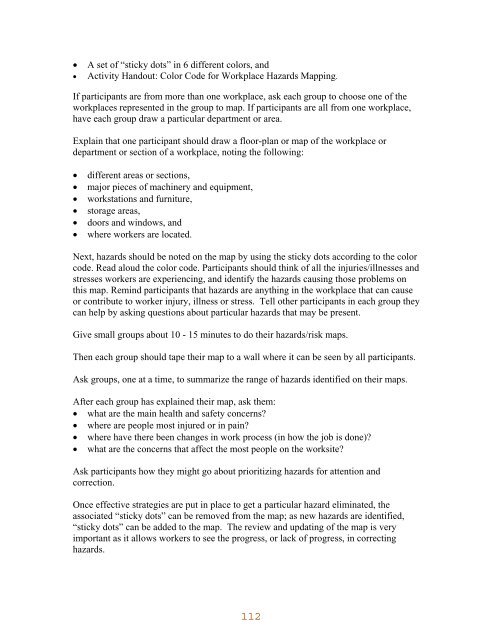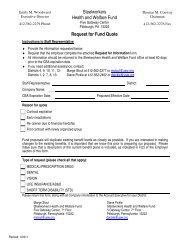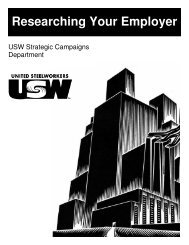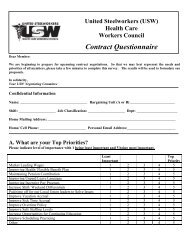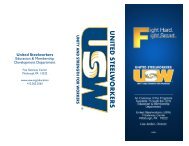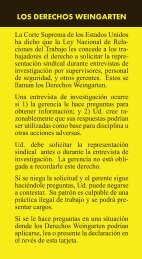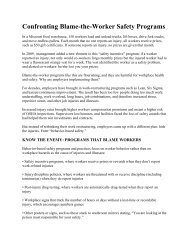Union Approach to Health and Safety: - United Steelworkers
Union Approach to Health and Safety: - United Steelworkers
Union Approach to Health and Safety: - United Steelworkers
Create successful ePaper yourself
Turn your PDF publications into a flip-book with our unique Google optimized e-Paper software.
A set of “sticky dots” in 6 different colors, <strong>and</strong><br />
Activity H<strong>and</strong>out: Color Code for Workplace Hazards Mapping.<br />
If participants are from more than one workplace, ask each group <strong>to</strong> choose one of the<br />
workplaces represented in the group <strong>to</strong> map. If participants are all from one workplace,<br />
have each group draw a particular department or area.<br />
Explain that one participant should draw a floor-plan or map of the workplace or<br />
department or section of a workplace, noting the following:<br />
<br />
<br />
<br />
<br />
<br />
<br />
different areas or sections,<br />
major pieces of machinery <strong>and</strong> equipment,<br />
workstations <strong>and</strong> furniture,<br />
s<strong>to</strong>rage areas,<br />
doors <strong>and</strong> windows, <strong>and</strong><br />
where workers are located.<br />
Next, hazards should be noted on the map by using the sticky dots according <strong>to</strong> the color<br />
code. Read aloud the color code. Participants should think of all the injuries/illnesses <strong>and</strong><br />
stresses workers are experiencing, <strong>and</strong> identify the hazards causing those problems on<br />
this map. Remind participants that hazards are anything in the workplace that can cause<br />
or contribute <strong>to</strong> worker injury, illness or stress. Tell other participants in each group they<br />
can help by asking questions about particular hazards that may be present.<br />
Give small groups about 10 - 15 minutes <strong>to</strong> do their hazards/risk maps.<br />
Then each group should tape their map <strong>to</strong> a wall where it can be seen by all participants.<br />
Ask groups, one at a time, <strong>to</strong> summarize the range of hazards identified on their maps.<br />
After each group has explained their map, ask them:<br />
what are the main health <strong>and</strong> safety concerns?<br />
where are people most injured or in pain?<br />
where have there been changes in work process (in how the job is done)?<br />
what are the concerns that affect the most people on the worksite?<br />
Ask participants how they might go about prioritizing hazards for attention <strong>and</strong><br />
correction.<br />
Once effective strategies are put in place <strong>to</strong> get a particular hazard eliminated, the<br />
associated “sticky dots” can be removed from the map; as new hazards are identified,<br />
“sticky dots” can be added <strong>to</strong> the map. The review <strong>and</strong> updating of the map is very<br />
important as it allows workers <strong>to</strong> see the progress, or lack of progress, in correcting<br />
hazards.


